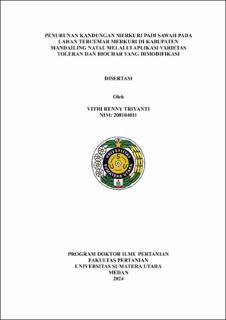Penurunan Kandungan Merkuri Padi Sawah pada Lahan Tercemar Merkuri di Kabupaten Mandailing Natal melalui Aplikasi Varietas Toleran dan Biochar yang Dimodifikasi
Reduction of Mercury Content in Rice Paddy on Mercury-Contaminated Land in Mandailing Natal Regency through the Application of Tolerant Varieties and Modified Biochar

Date
2024Author
Triyanti, Vitri Renny
Advisor(s)
Rosmayati
Basyuni, Mohammad
Damanik, Revandy Iskandar Muda
Metadata
Show full item recordAbstract
Mandailing Natal Regency is administratively located in the province of North Sumatra, covering an area of 662,070 hectares, with 40,051 hectares of rice fields. The Batang Gadis River, which flows for 180 km, serves as a vital resource for the residents of Mandailing Natal Regency, providing drinking water, irrigation, and a source of protein in the form of fish. Unauthorized gold mining (PETI) is widespread in the districts of Muara Sipongi, Ulu Pungkut, Kotanopan, Hutabargot, and Naga Juang. The use of mercury in the amalgamation process of gold mining results in mercury waste, all of which is discharged into the Batang Gadis River. Initial analysis by researchers at four points in the rice fields irrigated by the Batang Gadis River showed mercury levels of 13.7 mg/kg in the soil and 0,07 mg/kg in plant biomass. These results indicate mercury levels far above the quality standards for soil and rice plants. This analysis supports the researchers' suspicion regarding the high number of children born with disabilities in Mandailing Natal Regency due to mercury exposure. Therefore, it is necessary to conduct research to reduce mercury exposure by decreasing mercury content in the soil and reducing mercury absorption in rice grains, which are the primary food source for the Mandailing Natal community. The general aim of this doctoral dissertation research is to reduce mercury absorption in rice grains. Specifically, the research aims to: (1) analyze mercury content in soil and rice plants in Mandailing Natal Regency, (2) identify high-yield rice varieties with low mercury content in the grains, and (3) determine the best remediation materials to lower mercury content in soil and plants. The research begins with the analysis of mercury in soil and plants at various points in rice fields irrigated by the Batang Gadis River. Subsequently, variety screening is conducted at the early vegetative stage. The first study is designed using a two- factor randomized block design (RBD) with three replications, investigating mercury concentration and 23 varieties (consisting of local varieties, inbred lines, hybrids, and superior varieties). The second study is designed using a split-plot design (SPD) with the main plot being biochar modifications consisting of M1 (modified with Fe3O4), M2 (modified with sulfur), M3 (modified with dolomite), and unmodified (M0). The subplot factor is the pyrolysis temperature with two levels, 350°C (S1) and 550°C (S2). The sub-subplot factor is the variety consisting of three selected varieties from the first study (V1: toletan, V2: moderat, and V3: sensitive). The research units are supplemented with three controls without biochar (V1, V2, and V3), resulting in 27 treatment units repeated three times. The biochar material used is coconut shell. The experiment observed parameters such as Hg content in roots, stems, leaves, grains, and production. Among the 23 varieties tested in the first study, morphophysiological analysis showed 15 varieties were tolerant, 5 were moderate, and 3 were sensitive. DNA analysis indicated 13 varieties encode metallothionein genes. Biochar modification with Fe3O4, FeSO4, and dolomite could reduce mercury content in grains below the quality standard threshold. The best modification for reducing mercury content below the threshold and increasing production was the Fe3O4 treatment combined with the IF-16 variety.
